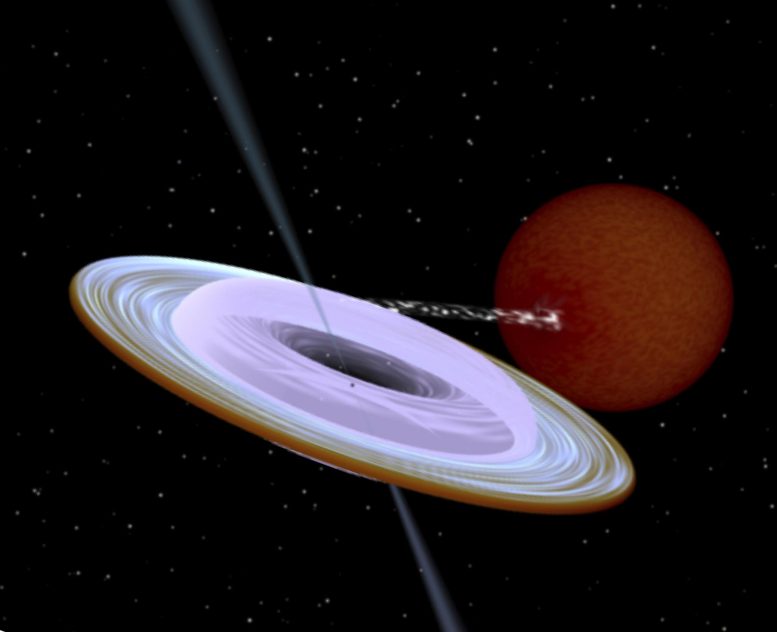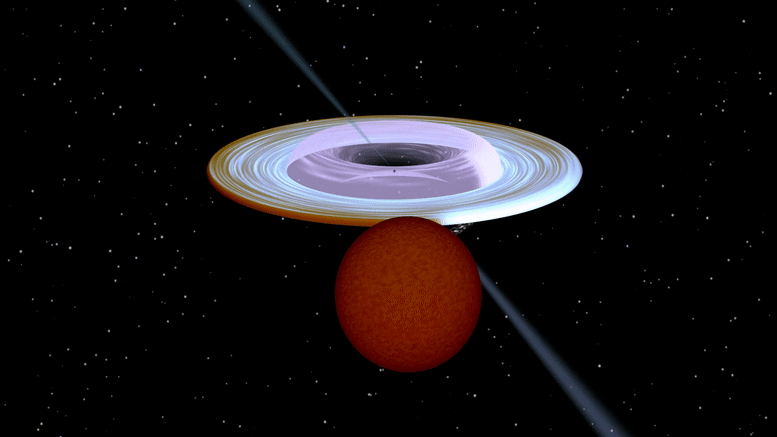Vědci z University of Turku ve Finsku zjistili, že rotační osa a[{“ attribute=““>black hole in a binary system is tilted more than 40 degrees relative to the axis of stellar orbit. The finding challenges current theoretical models of black hole formation.
The observation by the researchers from Tuorla Observatory in Finland is the first reliable measurement that shows a large difference between the axis of rotation of a black hole and the axis of a binary system orbit. The difference between the axes measured by the researchers in a binary star system called MAXI J1820+070 was more than 40 degrees.

Artist impression of the X-ray binary system MAXI J1820+070 containing a black hole (small black dot at the center of the gaseous disk) and a companion star. A narrow jet is directed along the black hole spin axis, which is strongly misaligned from the rotation axis of the orbit. Image produced with Binsim. Credit: R. Hynes
Often for the space systems with smaller objects orbiting around the central massive body, the own rotation axis of this body is to a high degree aligned with the rotation axis of its satellites. This is true also for our solar system: the planets orbit around the Sun in a plane, which roughly coincides with the equatorial plane of the Sun. The inclination of the Sun rotation axis with respect to orbital axis of the Earth is only seven degrees.
“The expectation of alignment, to a large degree, does not hold for the bizarre objects such as black hole X-ray binaries. The black holes in these systems were formed as a result of a cosmic cataclysm – the collapse of a massive star. Now we see the black hole dragging matter from the nearby, lighter companion star orbiting around it. We see bright optical and X-ray radiation as the last sigh of the infalling material, and also radio emission from the relativistic jets expelled from the system,” says Juri Poutanen, Professor of Astronomy at the University of Turku and the lead author of the publication.
Umělecký dojem z rentgenového binárního systému MAXI J1820 + 070, který obsahuje černou díru (malý černý bod ve středu plynného disku) a doprovodnou hvězdu. Podél osy rotace černé díry je nasměrován úzký výtrysk, který je silně vychýlen od osy rotace oběžné dráhy. Obraz byl vytvořen s vánkem. Kredit: R. Hynes
Sledováním těchto výtrysků byli vědci schopni velmi přesně určit směr rotační osy černé díry. Když se množství plynu padajícího z doprovodné hvězdy do černé díry později začalo snižovat, teplota systému se ochladila a velká část světla v systému pocházela z doprovodné hvězdy. Tímto způsobem se vědcům podařilo změřit sklon oběžné dráhy pomocí spektroskopických technik, a to se zhruba shodovalo se sklonem balistiky.
„Abychom určili 3D orientaci oběžné dráhy, potřebujeme také znát poziční úhel systému na obloze, což znamená, jak se systém otáčí vzhledem ke směru na sever na obloze. To bylo měřeno pomocí polarimetrických technik,“ říká Juri Potanin.
Výsledky publikované v Science otevírají zajímavé vyhlídky směrem ke studiu tvorby černých děr a evoluce takových systémů, protože je obtížné dosáhnout takové extrémní nerovnováhy v mnoha scénářích tvorby černých děr a binární evoluce.
Rozdíl více než 40 stupňů mezi osou oběhu a rotací černé díry byl zcela neočekávaný. Vědci často předpokládali, že tento rozdíl je velmi malý, když modelovali chování hmoty v zakřiveném časovém prostoru kolem černé díry. Stávající modely jsou již složité a nové poznatky nás nyní nutí přidat jim nový rozměr,“ říká Potanin.
Reference: “Nerovnováha rotace černé díry na oběžné dráze v rentgenové binární soustavě MAXI J1820+070” od Guri Potanin, Alexandra Veledina, Andrei V Berdyugina, Svetlana V Berdyugina, Helen Germak, Peter J. Juncker, Gary JE Kagava, Ilya Kozenkov, Vadim Kravtsov Filippo Perola, Manisha Shrestha, Manuel A. Perez-Torres a Serge S. Tsygankov, 24. února 2022 K dispozici zde. vědět.
DOI: 10.1126 / science.abl4679
Hlavní objev byl učiněn pomocí vlastního polarimetru DIpol-UF instalovaného na Northern Optical Telescope, který společně vlastní Univerzita v Turku s Aarhuská univerzita v Dánsku.

„Unapologetický analytik. Rozzuřeně skromný kávový evangelista. Hráč. Nelze psát s boxerskými rukavicemi. Student. Podnikatel.“
You may also like
-
Kompenzace spánku o víkendech může snížit riziko srdečních onemocnění o pětinu – studie | Srdeční onemocnění
-
Cesta miliardáře do vesmíru je „riskantní“
-
V lasvegaské krajské věznici byl hlášen případ planých neštovic
-
Nejvýkonnější dalekohled na Zemi zachycuje snímky černých děr v nebývalých detailech
-
Havárie asteroidu NASA Dart opravdu pokazila jeho vesmírný skalní cíl

